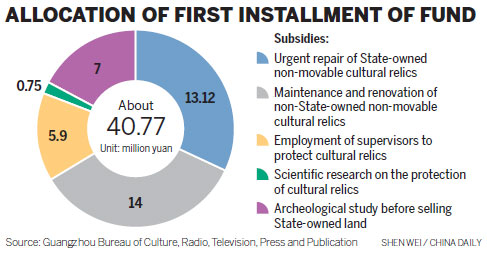Historical sites include ancestral halls, traditional dwellings, bridges
Guangzhou, the capital of Guangdong province, has added 80 sites to its protection plan for historical buildings and scenic areas.
Experts said the inclusion will help to further preserve the traditions of a city with a history of more than 2,200 years that has been undergoing increasing urbanization.
City authorities approved the listing of the 80 sites on Tuesday. Taking into account a list approved in December, there are now 478 historical buildings under the protection plan.
The historical buildings in the December list are concentrated in the city's three old districts, while the locations in the new list cover all 11 of its districts.
The newly included sites mainly supplement Guangzhou's catalogue of historical buildings with cultural heritage, such as traditional dwellings, ancestral halls, industrial heritage items such as abandoned factories in the city's former suburbs as well as structures like bridges and wells.
Guangzhou Mayor Chen Jianhua said on Tuesday that the second list of historical buildings covers an unprecedented vast region of both urban and suburban areas that enriches Guangzhou as a historical and cultural city.
The current city government values the protection of historical buildings "as never before", with the mayor stressing that the government will be more devoted to protection efforts to leave a rich cultural heritage for future generations, according to a statement from the Guangzhou Urban Planning Bureau.
The city's protection plan of historical buildings and scenic areas was approved in November and implemented from February. The plan is detailed in its protection stipulations of historical buildings, such as maintenance for facades and restrictions on new construction within a certain area around the buildings.
But the protection of historical buildings is more than just about maintaining the architecture, said Professor Wang Yuanlin from the Guangzhou-based Jinan University's history department.
"It is equally important to preserve and revive the traditional customs inherent within the historical buildings," Wang said on Wednesday.
"Many ancestral halls, where worship ceremonies and villagers' group meetings took place, are now empty shells because young people have left their homes to live in urban areas and did not inherit the traditions."
Wang said the country's rapid urbanization has caused ancient villages to disappear every day in China. But he also said that the old can coexist with the new, citing the remodeled Liede Village to the south of the city's new CBD Zhujiang New Town as an example.
Although the area's shabby, crowded houses were torn down to make way for modern apartment buildings, the developers kept the Longmu Temple and rebuilt around the ancestral halls and representative traditional houses. A museum was also built to display the village's history and filled with historical items such as an old dragon boat's bow.
Jinan University's aging office building was included in the new list of historical buildings as a representation of the city's educational buildings during the period from 1912 to 1949. The building has been given a new lease on life as home to the university's art faculty.
"Graduates from Jinan University love taking photos in front of the old office building when they revisit the campus. So we are preserving students' precious memories in preserving the building," Wang said.
"Similarly, it is important to protect Guangzhou's historical buildings as a way to preserve local people's precious memories. It is wise for the government to protect these buildings with laws and regulations."
He Baoqi contributed to this story.
xujingxi@chinadaily.com.cn
|
More historical buildings and scenic areas are included in the protection plan in Guangzhou, Guangdong province. The city will also set up a special fund of 60 million yuan ($9.6 million) to preserve its cultural relics. Among the buildings to be protected are (clockwise from top left) the Nanye Ancestral Temple, Donghu Lock, a warehouse in Huaqiao Sugar Refinery and an old office buidling in Jinan University. Provided to China Daily |

